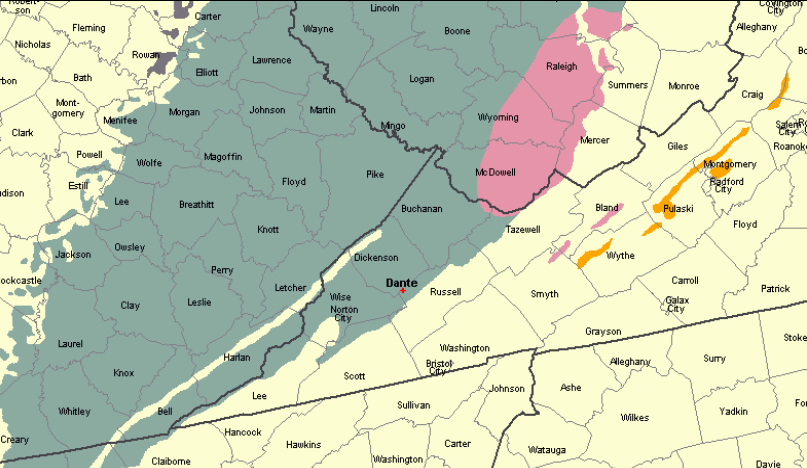
Dante, at edge of coal fields
Source: USGS National Atlas
In the 1880's-1920's, the railroad and coal companies created communities exclusively for mining coal. Company towns such as Dante in Russell County evolved in three phases:1
Coal mining started in different communities by an investor hiring local residents. At Merrimac in Montgomery County, coal seams were excavated initially with a labor force that farmed part-time as well as worked in the mines.
Most coal mines were on the Appalachian Plateau, and the supply of part-time local labor was insufficient in the isolated mountain counties. Coal companies brought in entire trainloads of workers and housed them in newly-constructed company towns.
Ethnic and racial groups tossed together by the coal companies struggled to establish new social norms in the new communities. In the "instant" coal and logging camps, there was very little time for adjusting to the social stresses and dislocations. Not surprisingly, the cultural diversity from new immigrants was not always welcomed by other immigrants or the local population - especially when coal companies imported blacks from further south.
In contrast to Southside Virginia, where racial tension was high but the white and black communities accommodated to each others demands based on tradition and custom developed over centuries of interaction, there was more racial violence (lynchings) in Southwestern Virginia than in any other region of the state between the Civil War and World War I, as Virginia passed from Reconstruction to Jim Crow segregation.
The foreign miners, though perhaps victims of discrimination themselves, could be as racist as the typical Virginians of the day. Tensions erupted into violence often in the coal camps, and reflected the lack of community and "belonging" to a place. Legal procedures were slow and the "law" was untrusted, but a lynching brought quick closure to an accusation of guilt - with or without justice.
There was a relatively high number of lynchings within the small population of Southwest Virginia. This reflected the extra-judicial means used to establish authority and economic control among groups whose social relationships were unclear. Without the stimulus of high-value coal, the settlement of the region would have been slower, cultural adjustments would have been gentler, and the sad accounts of racially-tinged murder would have been fewer.

Dante, at edge of coal fields
Source: USGS National Atlas
When the mines were closed, many of the coal camps closed up too. Some coal towns, some "central places" such as Dante in Russell County, have survived. Dante was the headquarters of the Clinchfield Coal Corporation, and its population peaked with 3,800 residents. Residents there established a close enough sense of community to remain together even through the economic dislocations. As mines closed and automation reduced the number of miners needed to extract a ton of coal since World War II, the remaining residents in the surviving coal towns have adapted and chosen to stay rather than move away.